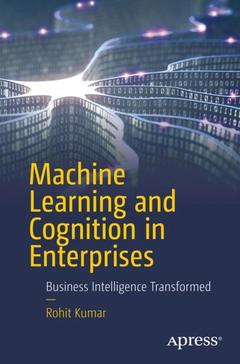Chapter 1: Journey of Business Intelligence
Chapter Goal: How and why Business Intelligence term was coined. What were the various phases of the same and until now why need is there to move to a different model with focus on Cognitive computing is required?
No of pages : 20-25
Sub -Topics
1. Business Intelligence
2. Why it started?
3. Initial use cases
4. Later use cases
5. Shifting paradigm of Business Intelligence
6. Case Studies to differentiate
Chapter 2: Why Cognitive and Machine Learning
Chapter Goal: This chapter moves around as extension to previous one and covers why cognitive was a natural choice of evolution
No of pages: 4-5
Sub - Topics
1. Why Machine Learning and Artificial Intelligence were required
2. Why towards cognitive
Chapter 3: Machine Learning Basics
Chapter Goal: Introduction to Machine Learning basic and business examples to understand Business Intelligence.
No of pages : 30-35
Sub - Topics:
1. Definition
2. Problem and task differentiation
3. Approaches to Machine Learning
4. Knowledge Discovery and search Methods
5. Statistics part of it
6. Applications
7. Business use case examples
Chapter 4: Artificial Intelligence Basics
Chapter Goal: Introduction to Artificial Learning basics and business examples to understand usability from business user perspective.
No of pages: 20-25
Sub - Topics:
1. Background and Overview
2. Why Artificial Intelligence
3. Tools and approaches
4. Applications
5. Business use case examples
Chapt
er 5: Natural language Processing
Chapter Goal: Introduction to Natural Language processing basics and examples to understand usability user perspective
Pages: 20-25
1. Overview
2. NLP and Machine Learning
3. How it works
4. Business use case examples
Chapter 6: Predictive analytics
Chapter Goal: Introduction to basics and examples to understand Business Intelligence from business user perspective
Pages: 30-35
1. Overview
2. Types
3. Applications
4. Tools
5. Business use case examples
Chapter 7: Cognitive Computing
Chapter Goal: Introduction to basics and examples to understand Business Intelligence from business user perspective
Pages: 30-35
1. What is cognition
2. Cognitive Architecture
3. Cognitive Computing Overview
4. Why cogni
tive
5.
How much is available now
6. Cognitive computer
7. Applications
8. Business use cases
Chapter 8: Principle for cognitive designed systems
Chapter Goal: Introduction to concept. How a problem to solution map is created for enterprise IT – Business Intelligence landscape to create a cognitive and learning system.
Pages: 35-40
1. What it means
2. Approach
3. Cognitive Work Analysis
4. Functional Workspace design
5. Corpus building and indexing
6. Sources of data and knowledge
7. Training cognitive systems
8. Interfaces
9. Do they fail too?
10. Components of Machine Learning and Artificial Intelligence
Chapter 9: New Term : Self/Parallel Evolving IT-Business Intelligence systems
Chapter Goal:I have come up with this new concept and termed
it as above. This has been largely appreciated and is a new dimension thought provoking concept of how cognition can go to the extent to become a self-evolving IT-Business Intelligence landscape and how it can grow parallel to business.
Pages: 35-40
1. Boundary between IT and Business
2. Where they stand today
3. Where they head to
4. Why this is game changer
5. Is this too complicated
6. What is the new IT for business?
7. Future trends and predictions
8. Hypothetical case study to summarize
9. Summary
Chapter 10: Roadmap for Transformation
Chapter Goal: Extension to previous chapter and talks about how to achieve the same.
Pages: 40-45
1. Digital business transformation
2. Why required?
3. Elements of digital transformation
4. Holistic Transformation and Optimization
5. Some industry sector e
xamples
6. Sample/Example Roadmaps
7. Summary
Chapter 11: Roadblocks for Transformation
Chapter Goal: Extension to previous chapter and talks about roadblocks.
Pages: 20-25
1. Bare reality of transformation
2. Cognitive vs Other Transformation
3. Change the way you draw transformation path
4. Prime stakeholders
5. Timing right entry at right time
6. Risks and Perceptions
7. What to expect
8. Reality check
9. Summary
Chapter 12: Self evolving Cognitive business systems
Chapter Goal: Talks about the concept of self-evolving business systems. Core concept dealt in chap 9. This extends after understanding complete concept up to transformation and roadblock to explain what it is and what not. And some detailed business examples.
Pages: 20-25
1. What it is and what not
2. New
age of Business and IT collaboration
3. Future of IT and Business Intelligence for business
4. Some business scenario use cases
5. Summay
Chapter 13: Case Studies
Chapter Goal: Case studies from 5 industries.
Pages: 20-25
1. Case study 1
2. Case study 2
3. Case Study 3
4. Case study 4
5. Case study 5
Chapter 14: IBM Watson
Chapter Goal: This chapter describes Watson
Pages: 20-25
6. Know Watson up to barebones
7. Jeopardy
8. Applications
9. Learning options
10. Interface resources
Chapter 15: Path ahead
Chapter Goal: This chapter specifically answers in light of complete content of book three areas. Path ahead for organizations, IT Service organizations and IT consultants.
Pages: 10-15
1. Path Ahead: Organizat
ions
2.
Path Ahead: IT Service Organizations
3. Path Ahead: IT consultants.





